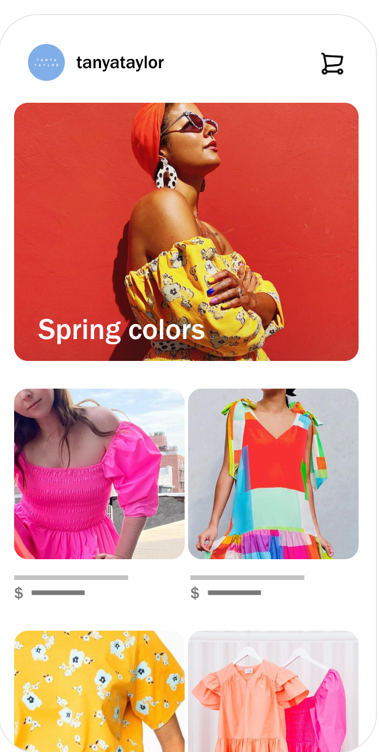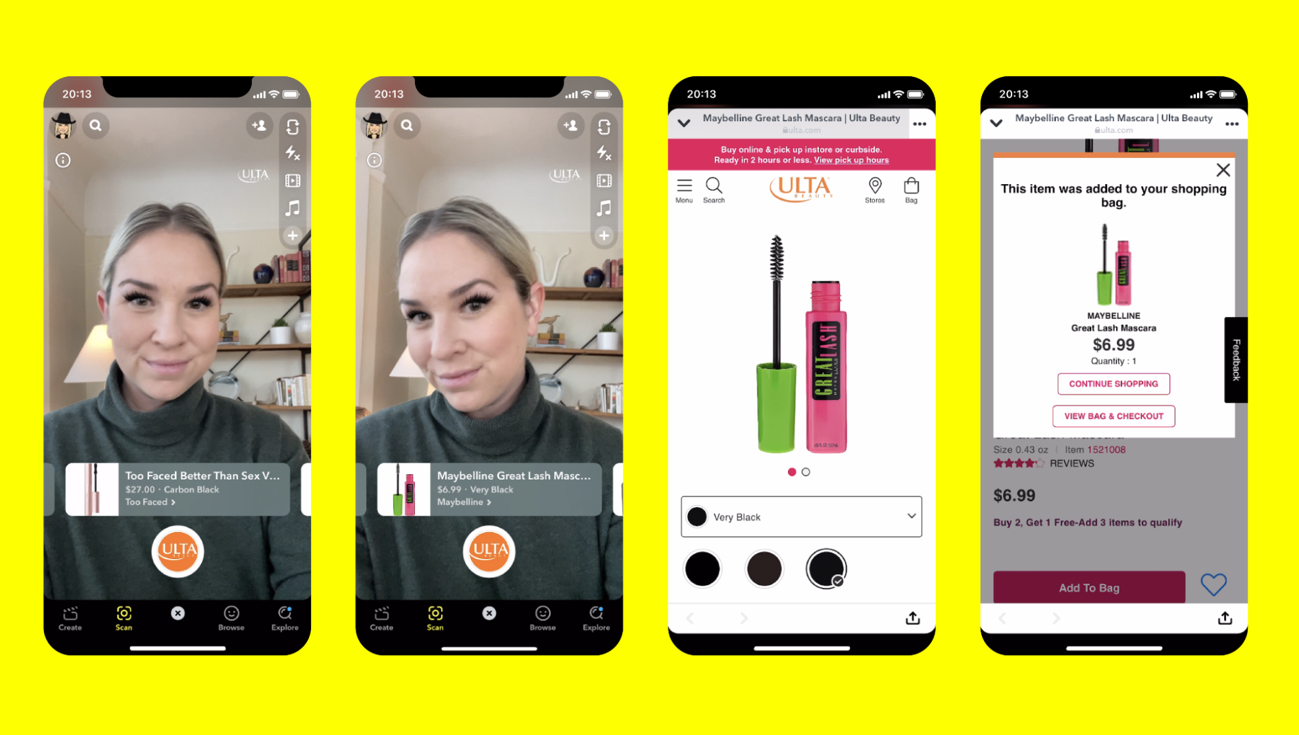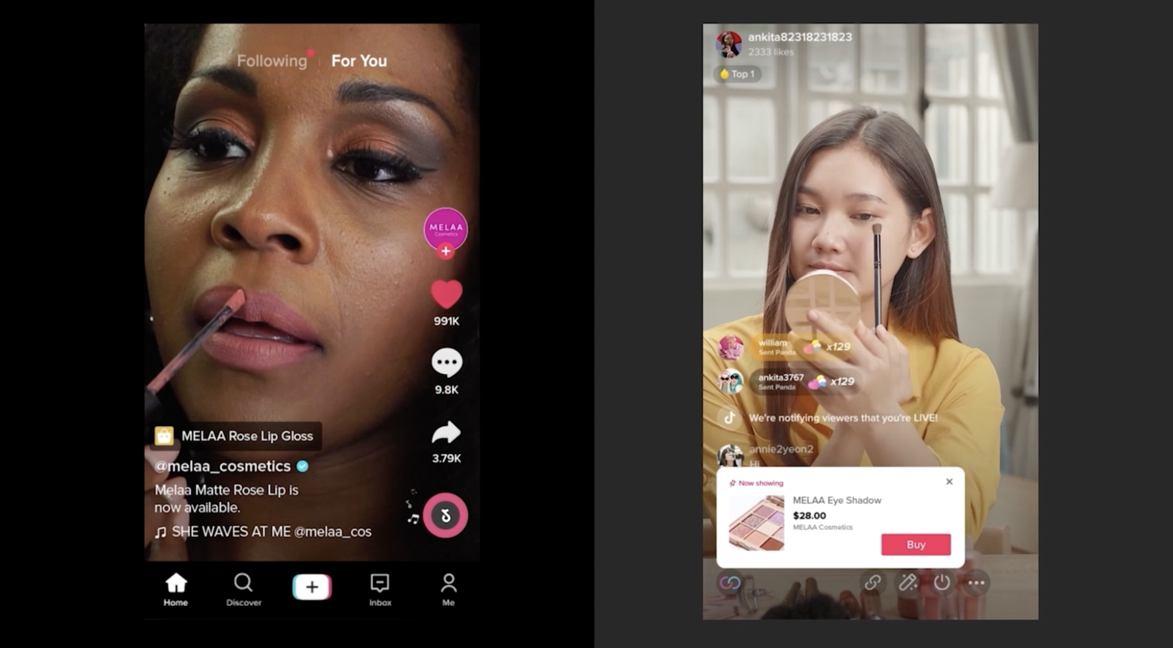Social Commerce Guide: Definition, Best Practices & Examples

Have you ever been looking through your social media feed, and seen a scroll-stopping product you’d like to purchase? Did you find yourself wishing you could buy it right then and there? With social commerce activations in place, now, you can.
Brands have taken notice of this growing opportunity to reach consumers where they are, and for good reason. Roughly half of all U.S. social network users between the ages of 18 to 34 will make at least one social commerce purchase via platforms like Facebook, Pinterest, Instagram, TikTok, Twitter, or Snapchat. And with Meta and TikTok introducing new and improved native shopping experiences, that number will only continue to rise.
In this post, we’ll cover how brands can leverage these native shopping experiences — called social commerce — to reach new audiences and boost sales. Let’s start with the basics.
Table of contents:
Social commerce refers to buying or selling a product or service within the native social media experience. For example, on Instagram, users can browse and purchase products right from the Instagram app, rather than having to take the extra step of going to the brand’s website.
Social commerce is the way of the future when it comes to making the path to purchase seamless and the numbers prove it.

Social commerce is a subset of ecommerce. Typically, online shoppers discover a new product in an organic or paid social media post, then click through to the brand’s website to make a purchase.
In social commerce experiences, shoppers don’t have to leave the social media platform to make a purchase with Apple Pay, Google Pay, PayPal, or a credit card.
It’s clear social commerce is taking the industry by storm, but which platforms are rising to the top? Let’s break down some of the top platforms for social commerce and how the shopping experience works on each.
Facebook, owned by Meta, has been paving the way for social commerce in recent years. The platform has created the option for brands to construct online storefronts, AKA Shops, where consumers can browse and ultimately purchase products directly within Facebook.
Note: Shops are free to create but charge a fee when Facebook’s native checkout is used.
Facebook Shops is a culmination of online shopping features released the social platform over the years, including Facebook Marketplace, Native Checkout, and Live Video Shopping. Within Facebook Shops, businesses can create custom collections and tags to better reach customers, and according to Facebook, “any seller, no matter their size or budget, can bring their business online and connect with customers wherever and whenever it’s convenient for them.”
“Closing the gap between finding a new product and purchasing has become much easier when leaning into shopping ad units on Facebook and Instagram, such as the use of product tags or Instagram shops. Brands are going to need to ensure they are playing in this space in order to keep up with the fast-moving nature of its consumers.”

– Chelsea Dyjak, Sr. Manager, Paid Social at Tinuiti
If a brand doesn’t have access to Facebook Shops or Facebook’s native checkout, there are still opportunities to leverage social commerce. Facebook Marketplace allows users to purchase from local and ecommerce businesses alike without having to leave the Facebook app.
If you’re looking to put money behind your social commerce efforts on Facebook, you can do so by exploring Dynamic Ads, Collaborative Ads, Collection Ads, and Product Tags to get even more eyes on your products.
Instagram has very similar social commerce features to Facebook as they both embrace digital storefronts called ‘Shops’. When you set up your ‘Shop’, you have access to a variety of Instagram’s social commerce features like…
“We continue to see social platforms rolling out new paid and organic commerce features. We have already seen shops take off on Instagram and new features like live stream shopping and AR shopping on Snapchat also promise some success. I anticipate that we will continue to see more commerce products released this year playing further into the AR and video space.”

– Natasha Blumenkron Mears, Director, Paid Social at Tinuiti

Snapchat is also embracing the social commerce world in exciting and innovative ways. The social platform is leaning into augmented reality (AR) to reach consumers in a new and engaging fashion. Brands have the ability to work with Snapchat to create lenses that Snapchatters can use to try on makeup, eyewear, clothing, and so much more. Users can then review product information and click on a link to purchase through Snapchat’s native checkout or through a brand’s online store.
Snapchat recently reported that “Snapchatters are now engaging with AR more than 6 billion times per day, and 93% of them are interested in using AR for shopping.” And in January, the company revealed a new shopping lens where users can swipe through multiple products in one place. They noted that users will “see details on pricing, color, sizing, and similar items, right from the retailer. Lenses from Ulta Beauty & MAC Cosmetics are the first to use this new capability and in the coming months, Snapchatters will be able to shop using even more of these lenses made by brands they love.”

Snapchat is also incorporating new scanning features with the help of their scanning partners Yuka and Vivino. The app now gives users the ability to scan up to 1 million food products showing nutritional information, ingredients, and links to learn more and purchase products.
If you’re not quite ready to tap into AR, Snapchat has more traditional shopping offerings as well. In 2020, Snapchat announced that select accounts could create a store — powered by Shopify — within Snapchat to host more permanent content like catalogs, lenses, and digital storefronts.
During last year’s partner summit, Snapchat announced that profiles that included shopping links, which were previously limited to certain marketers/brands, are now open to additional businesses and brands. These accounts have the Shop button on their Snapchat profiles, allowing users to access the shops directly from a profile within the Snapchat app.
Lastly, brands can also utilize a variety of ads to easily drive conversions from the app. According to Snapchat, with the use of Dynamic Product Ads, “you can cast a wider net on the app and find prospective customers by serving them relevant products built directly from your product catalog.”
TikTok may be the newer kid on the block when it comes to social platforms, but with its growing popularity, the app is not lagging far behind when it comes to social commerce. This fall, TikTok announced the expansion of their shopping capabilities which includes live shopping, product tagging, storefronts, and more. TikTok noted that this update would feature “a suite of solutions, features, and advertising tools that empowers brands and merchants to meaningfully engage with their customers.”

The updates directly from TikTok included:
Source: TikTok
Brands such as e.l.f. saw big wins in recent years to the rise in TikTok engagement. e.l.f. Beauty partnered with Tinuiti in late 2019—shortly after we worked with the vegan beauty brand to create an integrated strategy across the social platform ecosystem.
Part of this strategy included launching three new channels for the brand—Snapchat, Pinterest, and TikTok—as part of their “e.l.f.ing Amazing” brand campaign. With this launch, Tinuiti helped e.l.f. become the first-ever beauty brand to advertise on TikTok. Our efforts resulted in 31M video views and 548,000 new users to elfcosmetics.com in just 90 days. This campaign ultimately helped lead to a greater engagement with TikTok—which included the viral #EyesLipsFace campaign.
“TikTok continues to disrupt the standard purchase journey as consumers on TikTok are looking for brands to entertain and allow them to participate, all while building trust through social proof. TikTok has changed the way that brands interact with their customers and we continue to see organic and paid solutions create viral shopping patterns through authentic UGC content.”

– Rachel Legere, Director, Paid Social at Tinuiti
With over 330 million monthly active users, Twitter offers a huge potential audience to ecommerce brands. While the site is mostly known for sharing news and quick tweets with a large audience, the platform is also dipping its toes into the world of social commerce – but they are not completely new to the game.
In previous years, Twitter included a shopping option directly within their site, but back in 2017, they decided to ditch their “Buy” button. Since then, Twitter has clearly seen the power of social buying and announced new features last year that will help them establish a bigger presence in the growing social shopping marketplace like a “Shop” button on tweets and a Twitter Shopping Card.
Just last month, Twitter announced a beta experiment called Twitter Shops. Twitter shared that “with Twitter Shops, merchants can handpick a collection of up to 50 products to showcase to shoppers on Twitter. The feature, which is free to use, gives people the chance to view products from the profiles of their favorite brands, so when you talk about and discover products on the timeline, you can now browse them on Twitter, too.”

We’re interested to see how this experiment takes flight and if Twitter will incorporate more shopping features into their platform in the future. Check out Twitter’s most recent blog for more info on Twitter Shops.
Did you know that 75% of weekly Pinterest users say they’re always shopping? Pinterest users are highly engaged and often start their shopping journey on the app. It’s an excellent hub for finding inspiration, but it’s also an amazing place to purchase products with their updated social commerce integrations.
If you’re interested in placing products on Pinterest, the first place to start is by setting up a catalog which is “a feed ingestion tool designed for businesses that sell products on their websites.” Once you’ve created a catalog, you can then create and manage product groups which is a collection of products that you’d like to feature on the Shop Tab Pinterest hosts or through promoted ads on their site.

There are a variety of advertising options on Pinterest to choose from where brands can feature specific products including Dynamic Shopping Ads which serve single image ads that promote a product relevant to people’s interests with helpful details such as delivery times, reviews, and promotions. There is also an option to utilize Shoppable Collection Ads which mix lifestyle imagery and video for an enhanced shopping experience where brands can link up to 24 products.
Last June, Pinterest also launched an additional social commerce feature called Shopping List. This newer feature automatically saves a user’s product pins into a central hub so when the time comes to make a purchase, the pinner can have easy access. In the Shopping List, users can see the price of the product, reviews, and pinners also get a notification if an item in their Shopping List drops in price.
Additional shopping features from Pinterest include (Source):
There’s clearly a lot going on in the Pinterest world and if you want to learn more about making the most of Pinterest marketing, check out our Complete Guide to Pinterest Ads.
Now that we’ve covered the top social commerce platforms, let’s take a look at a few examples of how brands are incorporating this strategy into their marketing toolkits.
Social commerce is a key piece of the ecommerce mix for brands across industries and this tactic has grown increasingly important in recent years. In fact, we’re already seeing it on the rise with retail social commerce sales in the U.S. expected to reach $79.64 billion by 2025. With more consumers utilizing social media as part of their daily routines, integrating shoppable experiences directly within an app is a no-brainer.
Let’s explore a few top benefits of social commerce…
During the past few years, we’ve seen big changes to both the ecommerce and retail industry. Consumers’ shopping habits have evolved toward digital-first shopping experiences and with social commerce, you can meet your target audience where they are – online. While many brands already embrace social commerce, the need to have a well-rounded digital retail strategy has become more critical than ever before.
It’s no secret that social media is an ideal place to build brand awareness. By creating engaging content on social media platforms users become familiar with your brand, products, and services on a personal level. In fact, it’s been reported that familiarity with a brand makes users more likely to purchase their products on social.
The ultimate goal of social commerce is to eliminate any friction in the buying process, and incorporating social commerce into your marketing strategy allows you to do just that. With social commerce in place, users won’t even need to leave the social app when purchasing your product – a true win-win for both sellers and buyers.
By using social commerce, you have access to valuable online and offline data that can help you build customer personas as well as in-depth customer profiles to create better and more personalized shopping experiences. By having this data at your fingertips, you can also create and adjust omnichannel marketing campaigns to better reach and target potential customers.
When consumers buy a great product, they are eager to tell friends and family about it and this often happens through social media. By making the purchase experience quick and easy with social commerce, consumers are more likely to create a ‘buzz’ around your brand or product in an organic way.
The benefits are clear, but are there any other reasons why brands should consider incorporating social commerce into their strategy? These social commerce statistics help explain:
There are more consumers on social media than ever before and social commerce helps create a seamless experience that is unique compared to traditional ecommerce. The opportunity for marketers to see significant ROI in the social commerce space is there, and the time to take advantage of this growing medium is now.
As you can see, there are many benefits to entering the world of social commerce. Venturing into new territory can be overwhelming at times, but our experts highlighted top tips to keep in mind whether you’re new to social commerce or have been leveraging this tactic for some time. Take a look at their recommended best practices (from the crawling stage, to walking, to running) so your brand can be set up for social commerce success from the start.
To ensure your ads are optimized and proper results are being measured, it’s important to make sure that any pixels/conversion API integrations are set up correctly.
Social media product feeds are critical components to having a successful social commerce strategy. Before diving right into the world of social commerce, make sure your brand has up-to-date, accurate product feeds so you can set up your campaigns for optimal results from the start.
“Product feeds are the foundation for so many social commerce opportunities like dynamic product ads, product tags, collection ads, and live shopping. Successful merchants deliver rich, optimized up-to-date product info to each social platform as frequently as possible. Timely price and availability updates are essential low-hanging fruit–you don’t want to spend money or time on ads that incorrectly promote higher prices and out-of-stock products. Once you have the basics covered, you should invest internally or work with a partner to explore more advanced product feed strategy like A/B testing the product titles/images used in your ads or using performance-based product data feed labels to set up ad sets and campaigns.”

– Mike Wojciechowski, Senior Director, Shoppable Media at Tinuiti
Each platform that we’ve mentioned in this article has a variety of dynamic feed-based solutions you should consider exploring. We’ll cover a few of our favorites in our examples section below.
Testing ad formats before you officially invest in a social commerce campaign will help you convert more consumers while ensuring you don’t waste ad spend. For example, try testing frames, price overlays, and different price formats.
Move into more in-depth features of social commerce with an advanced catalog-enabled ad format. Testing collection ads is a great way to get started. According to Meta, “Each collection ad features a primary video or image with three smaller accompanying images below in a grid-like layout. Customers who tap on your collection ad to browse or learn more will be seamlessly taken to a fast-loading visual post-click experience (Source).”
Make the social commerce experience seamless for users by enabling product tags on posts. This way, all of your posts are shoppable at the moment of discovery.
As we covered, utilizing ‘Shops’ within Meta, Pinterest, TikTok, and Twitter is a great way to increase your success with social commerce. These shops are essentially digital storefronts where users are already spending their time so make sure to reach them there!
In-platform setup allows users to make purchases without leaving the platform – the bread and butter of social commerce. This significantly shortens the path to purchase and creates a positive and seamless experience for the buyer.
Live commerce allows users to shop in real-time during ‘live’ events on platforms like Facebook, Instagram, TikTok, Amazon, and more. This is a growing trend that many brands are embracing so it’s a great idea to test these capabilities.
Testing is a critical part of any advertising or marketing campaign. Social media platforms are consistently coming out with new ad types and offerings and testing and experimenting with these methods are great ways to see what works for your brand.
“When it comes to social commerce, it’s crucial to test early and often. Following platform best practices is an important first step, but what works for one brand may not be the optimal strategy for another. Seek to understand the unique product, audience, and ad type strategies that suit your brand’s needs. As credit card integration becomes more prevalent within our devices and social platforms, ecommerce will only account for more and more of brands’ annual sales.”

– Chris Stokes, Sr. Manager, Paid Social at Tinuiti
Now that we’ve covered the perks of using social commerce, let’s take a look at a few examples of how brands are incorporating this strategy into their marketing toolkits.
Now that you know the basics behind social commerce, it’s time to learn from the pros. Check out a few of our favorite social commerce examples below so you can get inspired for future campaigns.

Platform: Snapchat
Solution(s): Snapchat lenses + video ads
Highlights: Clearly, a popular eyewear brand, was looking to shake up their Snapchat advertising strategy by incorporating a shoppable Augmented Reality virtual try-on as well as simple, yet incredibly effective shoppable video ads within the Snapchat app. By using a Snapchat lens, Clearly allowed users to swipe through five different eyewear options for a virtual try-on and also gave them the opportunity to seamlessly purchase a style by directing Snapchatters to their site. Clearly also used a combination of Story Ads, Snap Ads, Collection Ads, and Dynamic Ads where users could easily swipe up or directly access product pages to make a purchase.
Results:
Snapchat reported the following results:

Platform: Facebook
Solution: Facebook Conversions API
Highlights: Eastern Standard Provisions wanted to strengthen the insights powering its ad campaigns so it could continue to increase brand awareness and sales as the ads ecosystem evolves. According to the case study released by Facebook, “the brand tested the implementation of the Facebook Conversions API, a secure integration tool that allows advertisers to share their data directly from their server, instead of through a browser. The first campaign used the Facebook pixel only, while the second campaign used the Facebook pixel and the Conversions API. Running catalog sales campaigns and conversion campaigns, the team applied dynamic ads, auto advanced matching, simplified account structure, campaign budget optimization, and automatic placements” (Source).

Results:
Eastern Standard Provisions determined the results of its Conversion API implementation from a conversion lift study, which highlighted (Source):

Platform: Instagram
Solution: Shops
Highlights: Jane, a boutique online marketplace, was looking to increase traffic and sales by creating an easier way for potential customers to find products during the holiday season. Jane utilized a shop on Instagram where consumers could browse through products, add items to carts, and make purchases. After conducting vast research, Jane’s team determined which products consumers were consistently looking for and curated various collections within their Instagram shop. To assist shoppers even further, Jane also tagged items within their Instagram posts so users could directly buy the product featured without leaving Instagram.
Results:
Check out Jane’s final results (Source)…
As we move further into 2022, social commerce will undoubtedly become a bigger piece of the ecommerce puzzle for brands and social platforms alike. If you’re ready to embrace all that social commerce can offer your brand, you’ve come to the right place. At Tinuiti, we have a team of social media experts who can level up your social commerce game and help drive conversions for your brand.
If you’re interested in leveraging social commerce now or in the near future, we’d love to help. For more information, please visit our Shoppable Media service page or contact us directly to get started.
